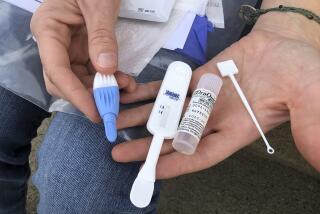AIDS Goals Within Reach
The United Nations AIDS program treated about 700,000 people in developing countries last year, putting the agency on course to achieve its goal of treating 3 million people by the end of this year, federal and global agencies said Wednesday.
A separate U.S. effort to provide anti-retroviral drugs to 2 million people by the end of 2008 is also ahead of schedule, treating 155,000 people in the programâs first eight months, U.S. AIDS czar Randall Tobias said.
The efforts of the U.N. and the U.S. are a âstrong but modest start,â said Dr. Richard Feachem, executive director of the Global Fund to Fight AIDS, Tuberculosis and Malaria. But he added that at least $2 billion more would be needed this year to reach treatment goals.
Tobias, Feachem and Dr. Peter Piot, head of UNAIDS, spoke to reporters Wednesday at the World Economic Forum in Davos, Switzerland.
Piot said UNAIDS enrolled 260,000 patients in the last six months of 2004. But he cautioned the program covered only 12% of the 5.8 million people in developing countries who will die in the next two years if they do not receive treatment. About 38 million people worldwide are living with HIV infections or AIDS, according to UNAIDS estimates.
When the program was conceived four years ago, many experts were skeptical about its chances of success. At that time, a year of treatment with the most commonly used drugs cost about $10,000 per person. No infrastructure was in place to deliver the drugs in many of the most heavily affected countries, and many critics did not believe that patients in those countries could adhere to the strict dosing schedules required for success.
But the costs of treatment have come down to as little as $300 per year, infrastructure has been slowly put in place, and adherence has been excellent, said World Health Organization Director-General Lee Jong-wook.
âWe are pleased to report that initial data show that adherence and treatment success rates in developing countries are similar to, if not higher than, those obtained in affluent, industrialized countries,â he said.
The UNAIDS report noted a 90% survival rate after one year and 80% after two years for those undergoing treatment.
Piot and others cited several obstacles that must be overcome for the program to succeed.
First, the agency hopes to lower the yearly cost of treatment to as little as $50. Second, researchers hope to sharply lower the cost of second-line treatments that are used when resistance develops to the most commonly used drugs.
Tobias said that the next milestone for the U.S. program, known as the Presidentâs Emergency Plan for AIDS Relief, is to have 200,000 people receiving treatment by June.
âI suspect that we are at or near 200,000 already,â he said in a telephone interview.
The presidentâs emergency plan got a boost Tuesday when the Food and Drug Administration approved a generic three-drug cocktail for AIDS made by Aspen Pharmacare of South Africa, making the drugs eligible for use in U.S. treatment programs. The decision marked the first time that foreign-manufactured anti-AIDS generics have been approved by the agency.
The Aspen drug cocktail sells for less than half the price of even sharply discounted brand-name drugs, so the approval should increase the number of people who can be treated with U.S. funds.
More to Read
Sign up for Essential California
The most important California stories and recommendations in your inbox every morning.
You may occasionally receive promotional content from the Los Angeles Times.







